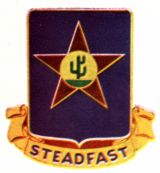|
Fredrick Foley
- Thank you for posting this site.
I was in both the 382nd Field Artillery and 409th Regiment,
2nd Battalion, Company F,
- Third Rifle Platoon. My
name is Fredrick Foley. I live in Battle Ground,
Washington. I certainly invite anyone
- from the 103rd to contact me.
I was captured in the Vosges Mountains, November 29, 1944 and
held by the Germans
- as a prisoner until the end of
the War where I was liberated by the Russians in
Czechoslovakia where I, and many
- others from different nations,
were laboring in an underground Aircraft Factory where Messer
Schmidt motors were
- being built. It was an SS
camp. Fortuitously, we were moved one day before the end
of the war from this camp.
- On a return trip in 1992, we
found the camp again and a memorial that the Czech people had
constructed to the
- brutal conditions we endured in
this camp. To my great surprise, we learned from the
memorial that the SS had
- executed all of the remaining
prisoners at this camp on the last day of the War,
approximately 100 people. We
- escaped this shooting by one
day. We finally found the Americans in Pilsen after
going through the Russian lines.
- We also barely escaped an order
from Stalin to hold all American prisoners who, as you
probably are aware, were
- never retuned to America, some
25,000 boys in all
|
- I was in the 103rd Div., 409th Regiment, Company F
and 382nd Field Artillery,
- Forward Observer. I was captured on November 29, 1944
with three other soldiers
- in the Vosges Mountains while working through enemy lines
attempting to connect
- telephone wire to a forward observer position.
Unfortunately we encountered a Company
- of Germans and after a very brief fire fight and an
escape, I returned to take a higher
- position on the hill. I was picked up by the end
of the skirmish line of the German
- Company surrounding us. It was apparent at that
time that we had encountered at
- least 100 Germans and there was no alternative except
surrender. As a result, I was
- taken to several internment and forced labor camps. I
was forced to work in a slave
- labor camp in Czechoslovakia commanded by the SS. We
were working on Messer
- Schmidt motors in an underground aircraft factory.
Prior to this labor I worked in a slave
- labor camp in Velky Senov, then called Gross Schoenau in
Czechoslovakia, very close to
- the German border. I was only thirty or forty miles
from Dresden while at this camp,
- during the infamous firebombing, which we could both see and
feel from this distance.
- The concussion was so great that we had to open up the
windows in the shoddy
- barracks they had given us to keep the glass from breaking.
We were liberated by
- the Russians coming from the East. In our camp there
were slaves from Yugoslavia,
- Poland, France, Hungary, even German political prisoners.
It was a very brutal camp
- in which we were worked hard and slowly being starved to
death. Many died from
- privation and disease. I weighed 90 pounds when I was
liberated. I nearly died from
- pneumonia, fever and tuberculosis directly after the
end of the war. Penicillin is probably
- what saved my life. Luckily, I made it back through
the Russian lines and barely
- escaped Stalin's order to keep all Americans. (You may
be aware that 25,000
- Americans were held by the Russians after the War and were
never returned. This is
- a dishonor and a horror in part committed by our own
Government, since we
- were aware of this fact and did nothing to demand their
return.) In 1992 I returned
- to Czechoslovakia. I found the last Camp I was at
which was run by the SS. We were
- moved from this Camp one day before the War ended to a
nearby Czech town, Benesov.
- A placard I had translated explained that everyone who
remained in the Camp,
- approximately 100 people, were executed by the SS. We
had missed the shooting by
- one day.
|
|
